Most Foreign Employers in New Hampshire Are Small
Employment data were collected[i] for 61% of the firms in our sample. The findings described in this chapter are based solely on this reduced data. Missing data is distributed somewhat in line with the pattern of foreign-owned subsidiaries presence across industries (at the 3-digit NAICS code). As available, ranges and actual number of employees were used to determine firm size class in accordance to the Bureau of Labor Statistics[ii].
The highest percentage of foreign subsidiaries in New Hampshire have 5-9 employees. 50% of foreign subsidiaries are very small, with fewer than 10 employees. Only 6% of firms have more than 250 employees. Large foreign firms have a significant contribution to employment in New Hampshire. Their size means that they likely champion supply chains and lead in economic and social contributions. Small foreign firms add diversity and may contribute to the overall entrepreneurial disposition. The small size of foreign firms is in line with the overall small business profile of the state. The US Small Business Administration notes that about 96% of New Hampshire businesses are small[iii]. Firms with fewer than 100 employees have the largest share of small business employment.
Distribution of Sample Foreign Firms by Size
| Firm class size | Percentage in total sample |
|---|---|
| Size class 1 (1 to 4 employees) | 17% |
| Size class 2 (5 to 9 employees) | 33% |
| Size class 3 (10 to 19 employees) | 20% |
| Size class 4 (20 to 49 employees) | 10% |
| Size class 5 (50 to 99 employees) | 7% |
| Size class 6 (100 to 249 employees) | 7% |
| Size class 7 (250 to 499 employees) | 3% |
| Size class 8 (500 to 999 employees) | 2% |
| Size class 9 (1,000 or more employees) | 1% |

The representation of firms in high-tech versus non-high-tech industries is relatively higher for firms that have between 50 and 99 employees. Foreign firms with 5 to 19 employees have the lowest proportion of high-tech industry representation. No single large high tech subsidiary with over 1000 employees appears in this sample.

The distribution of foreign firms with fewer than 20 employees verifies the strong presence in the credit intermediation industry. The merchants of durable goods follow on, with the clothing stores completing the top 3 industries represented. Some services, some manufacturing and heavy construction only have one firm of this size each. Foreign subsidiaries in the accommodation, the credit intermediation and the computer and electronic product manufacturing industries are in highest relative numbers when the size range of 20-249 employees is considered. Other manufacturing firms follow the top rank. Firms in machinery manufacturing, and petroleum and coal products manufacturing are also relatively well-represented.
A low number of foreign subsidiaries with more than 250 employees are in miscellaneous manufacturing and in the computer and electronic product manufacturing industry. Only one firm of this size operates in each of the other industries represented (mainly manufacturing: food; textile mills; petroleum and coal products; chemical; plastics and rubber product; nonmetallic mineral products; machinery, electrical equipment, appliance and components; and also merchant wholesalers of durable goods; credit intermediation and repair and maintenance). The charts below visualize the number of firms of selected size ranges across industries, as means to show how firms impact employment in New Hampshire.
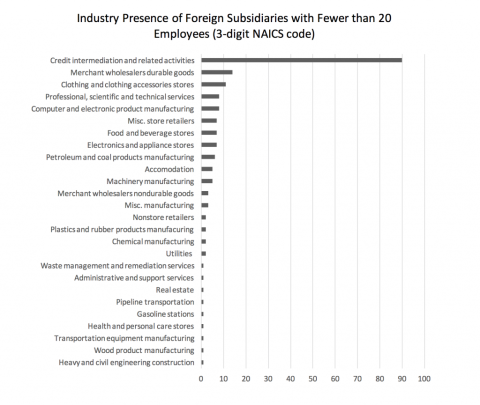
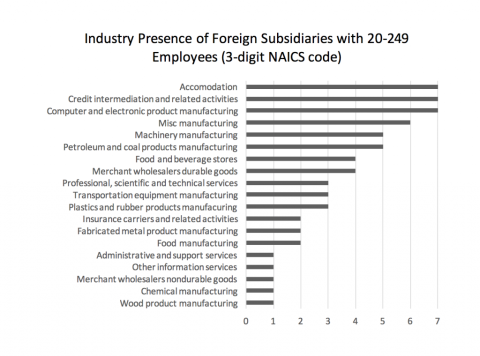
Small foreign firms have a predominant presence across counties. 31% of the sample firms in Hillsborough have 5-9 employees, and 22% have 10-19 employees. Only 5% of foreign subsidiaries in this county have more than 500 employees. Almost 90% of the sample firms have under 100 employees.

The distribution of foreign firms sample in Rockingham County shows that 33% of subsidiaries have 5-9 employees, and 31% have 1-4 employees. Almost 90% of firms have fewer than 50 employees. There are no firms with more than 500 employees.

Foreign firms in Merrimack County are again mostly small, with almost half having 5 to 9 employees. About 20% each represents subsidiaries with 10 to 19 employees and subsidiaries with 100 to 249 employees. There are no larger firms.
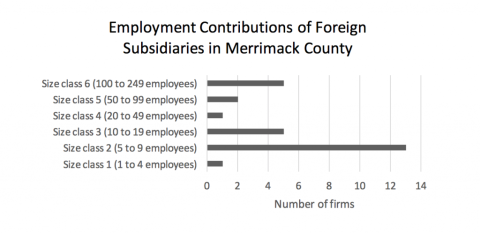
One company in the Grafton County sample has 100 to 249 employees. 36% of foreign firms in this county have 5 to 9 employees, with the remaining subsidiaries equally belonging in the other size classes.
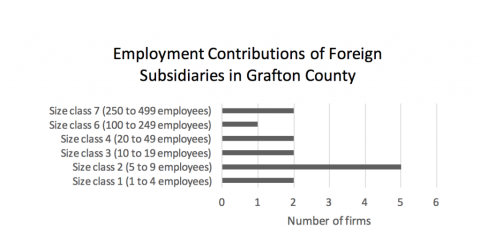
Almost 30% of foreign firms in Belknap County have 10 to 19 employees. About a quarter of the subsidiaries in this sample have 5 to 9 employees and another quarter are in the smallest size class.
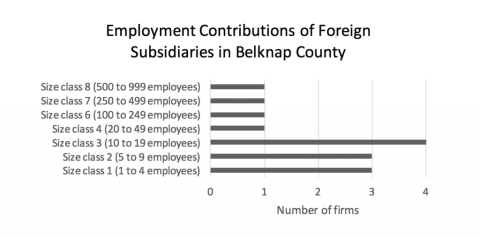
About one quarter of the 17 firms in Strafford County are in each of the smallest three size classes, followed by representation of firms with 100 to 249 employees. This sample also includes one firm of size class 4 and one relatively large firm of size class 8. Only a few Cheshire County subsidiaries for which employment data was available are in each of the size classes 1-6 and in class 9 (more than 1000 employees), for a total of 13 firms. Employment numbers were found for 14 foreign firms in Carroll County. The majority have 5-9 employees. No firms have more than 50 employees. All foreign subsidiaries in Coos County have fewer than 50 employees, with one exception of a firm in the size class 6. 7 firms were included in this sample. Only 4 foreign firms have employment data in Sullivan County, and they are in size classes 1,2,3 and 5, respectively.
Endnotes
[i] The number of employees for each foreign subsidiary was collected from http://www.amfibi.com and from http://listings.findthecompany.com/ . For a number of companies, only ranges of employee numbers were available.
[ii] Firm size classes are identified by the Bureau of Labor Statistics as: Size class 1 (1 to 4 employees); Size class 2 (5 to 9 employees); Size class 3 (10 to 19 employees); Size class 4 (20 to 49 employees); Size class 5 (50 to 99 employees); Size class 6 (100 to 249 employees); Size class 7 (250 to 499 employees);
Size class 8 (500 to 999 employees); Size class 9 (1,000 or more employees). https://www.bls.gov/bdm/bdmfirmsize.htm.
[iii] https://www.sba.gov/sites/default/files/advocacy/New_Hampshire.pdf.

